The Relative Merits of Black Rifle Evolution
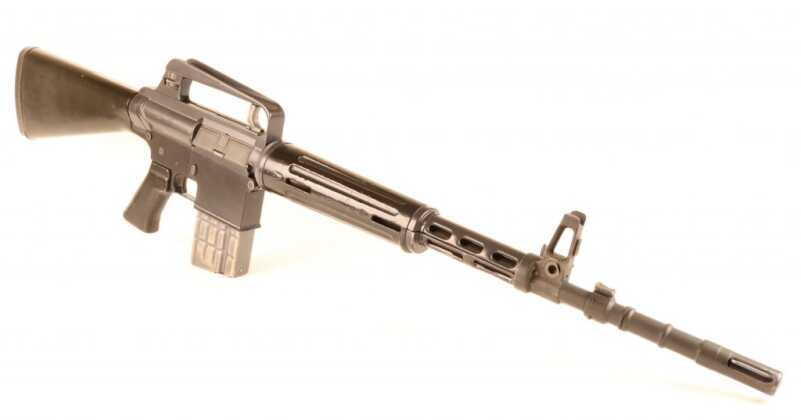
The original 1956-era AR-10 demonstrates the rudiments of the eventual definitive design.
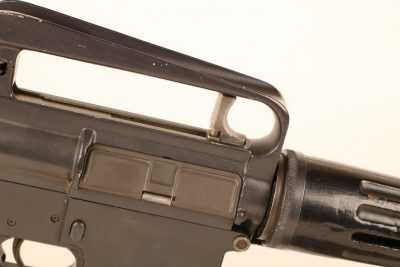
The original ArmaLite AR-10 had its charging handle as a trigger of sorts nestled within the charging handle.
ArmaLite began as a tiny little division of Fairchild Engine and Airplane Corporation in the early 1950s. Fairchild built a variety of trainer and transport aircraft during and after World War II. Their most recognizable creation was the 1970s-era A10 Warthog ground attack fighter.
Gene Stoner was the chief bottle washer at ArmaLite, and their mandate was to contrive the most technologically advanced military firearms designs on the planet. With a modest team of engineers, a few resources, and a remarkable excess of vision, these guys first strived to apply cutting-edge aviation technology to the development of small arms. Their efforts changed the way the world makes guns.
At the time the world’s proper Infantry weapons were all forged steel and oiled walnut. By contrast, the ArmaLite AR-10, itself the 7.62×51 mm precursor to the AR15, was built from aircraft aluminum and phenolic polymers. The gun’s earliest barrels were even made from thin steel sleeves embedded within an aluminum tube. After one of these rigs exploded brilliantly during a military demonstration the ArmaLite guys went back to more conventional steel barrels.
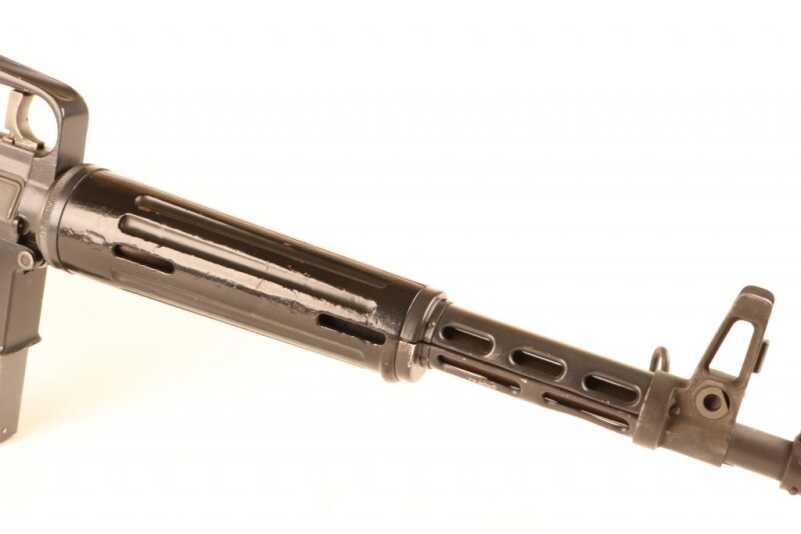
In the round polymer forearm and triangular front sight base of the AR-10, we see the beginnings of the M16.
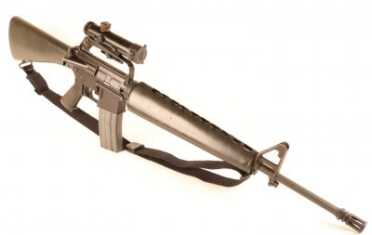
The M16A1 was the definitive model of the M16 used by the US military during the late 1960s, 70s, and 80s.
The extraordinary lines of those early black rifles were legitimately unlike anything else in the world. We are today jaded to polymer furniture, inline buttstocks, and aluminum gun parts. In 1956, however, this was heady stuff indeed. To a generation raised on Saturday afternoon Buck Rogers serials, the AR15 was science fiction incarnate. Despite some early challenges, the M16 went on to become the longest-serving military rifle in American history.
The direct gas impingement system that defined Stoner’s lightweight new rifle was drawn from the WWII-era Swedish Ljungman Automatgevär AG42 rifle. The machined aluminum receivers mimic aircraft structural components. The polymer pieces had their origins in the synthetic Bakelite of WWII.
Stoner designed the 5.56×45 mm round the AR15 fired using a modified .222 sporting cartridge as a foundation. The resulting rifle was radical to its core. American industry was capable of building such a high tech gun. Most of the rest of the world was not. Now hold that thought.
Morphological Details
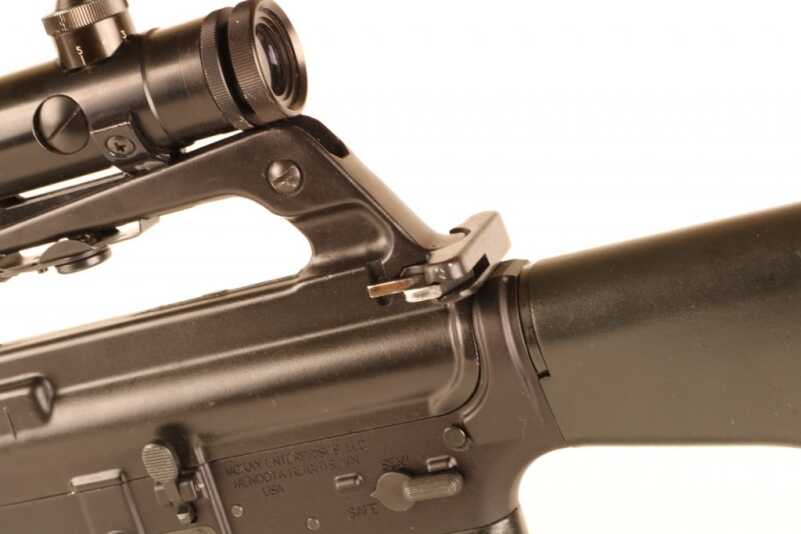
The familiar T-shaped charging handle had its debut in the 5.56mm AR15.
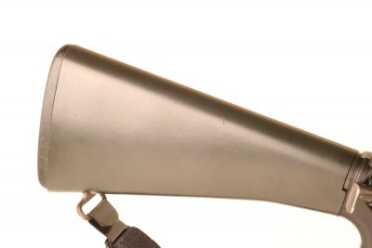
The polymer buttstock on the M16A1 was very similar to that of the AR-10 only smaller.
The AR-10 was the grandfather. In its odd space-age architecture, one can divine the rudiments of the definitive model yet to come. The plastic furniture bears a similarity to that of the later AR-15, while the iconic carrying handle and triangular front sight base begin to take form. The charging handle on those early guns was a trigger-looking appendage that slid within the carrying handle rather than today’s more familiar T-shaped apparatus.
The standardized M16A1 had evolved significantly by the time it was serving in the torrid jungles of Vietnam. The slick black triangular handguns sported cooling holes aplenty along with stamped heat shields to help keep them comfortable at high round counts. The sling attachment point was on the absolute wrong side of the buttstock for tactical employment but was rendered as a rigid appendage on the A1 model. This did little to make the gun easy to tote but did produce a nasty hand-to-hand weapon should some unfortunate American dogface ever have to resort to the art of the butt stroke.
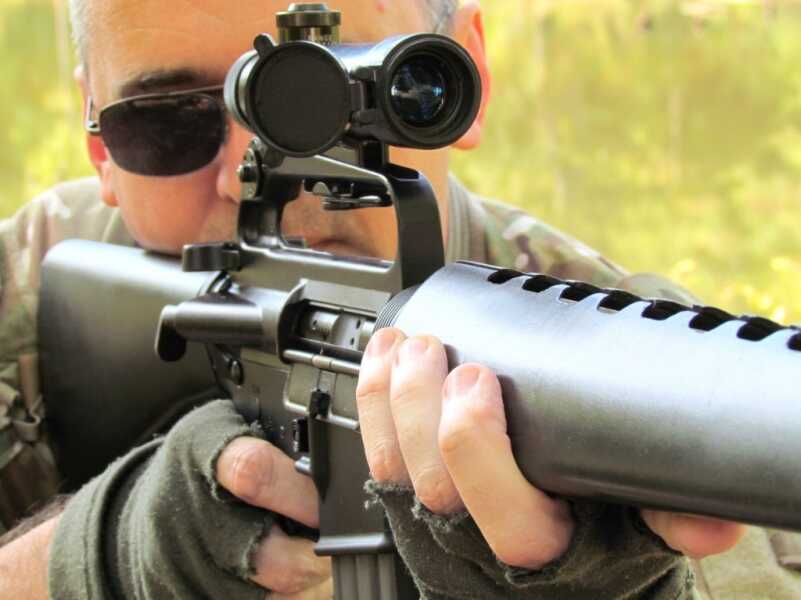
The M16A1
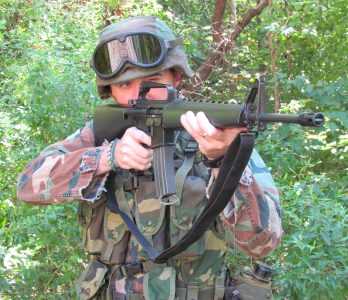
The recoil system telescoped into the buttstock such that the gun produced an audible twang with each round fired. Many’s the sweltering day I spent sweating on a military firing range as that buffer assembly cycled mere millimeters from my face. The overall experience was a visceral thing for a young soldier just getting comfortable in his uniform.
Despite the success of the M16, ArmaLite never planned on producing weapons. They were a think tank of sorts whose mission it was to design new guns and then farm them out for production under license. This was the reason most of those early ArmaLite rifles ended up with Colt’s prancing pony on the mag well. When the cash cow that was the AR rifle had been sucked dry it was time to build something new.
Generations

The M16A1
The M16 was a truly revolutionary rifle design. However, building one required the capacity to forge and machine aluminum to tight tolerances, draw stainless steel tubing, and manipulate parts in the same manner as the flourishing aerospace industry. In an effort at producing a rifle that was a bit easier to build in nations that perhaps lacked the technological wherewithal of the United States, Gene and his pals went back to the drawing board.
The next generation was actually called the AR-16. It fired 7.62x51mm, just like the original AR-10. The AR-16 massaged some of the high tech aspects of the previous design to allow the rifle to be built in simpler spaces. The AR-16 forewent the complicated forged receivers of the M16 in favor of simplified stamped steel versions.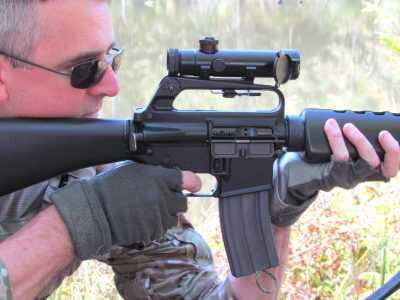
The Nazis showed the world exactly what advanced mass production techniques could do when they were unleashed upon small arms production. The MP40 submachine gun was the first example of a truly mass produced handheld automatic weapon. The MP44 could be churned out en masse by semi-skilled workers and might have changed the course of the war had it showed up a little earlier. The AR-16 was a variation on this theme.
In the process of this rethink, Mr. Stoner dispensed with the controversial direct gas impingement system of the M16 in favor of a more conventional gas piston design. American troops died in combat in Vietnam when the M16 rifles they were issued failed in the fetid filth of the Southwest Asian jungles. The elegant direct gas impingement design spilled scads of crud back into the rifle’s guts and was fairly maintenance-intensive as a result. The gas piston on the AR-16 was intended to remedy that.
Mr. Stoner left ArmaLite soon thereafter. As a result, the AR-16 died a natural death. However, another engineer named Arthur Miller designed a scaled-down 5.56×45 mm version called the AR-180 that was a piece of work indeed.
Technical Specifications
AR-180 M16A1
Caliber 5.56x45mm 5.56x45mm
Barrel Length 18.25 in 20 in
Overall Length 38 in (Extended) 39.5 in
Weight 6.7 lbs 6.35
Action Short-stroke piston Direct Impingement
Magazine Capacity 20/30/40 20/30/40
Differences
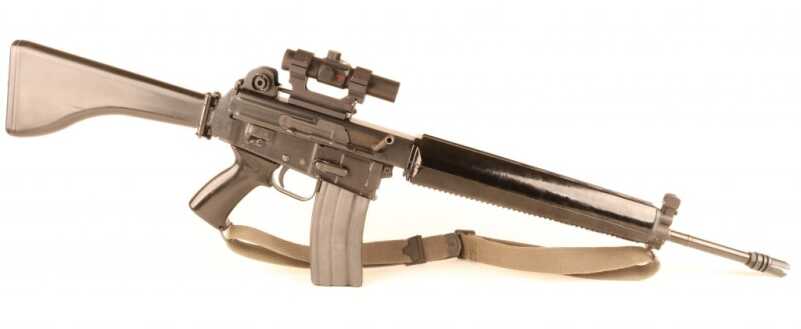
The ArmaLite AR-180 was designed after the M16 and was intended to be both more reliable and easier to produce.
The AR-180 was the semiauto civilian version of the selective fire AR-18 combat rifle. This gun was produced variously in England, California and Japan during the course of its production run. Most American enthusiasts got their introduction to the gun in the hands of Arnold Schwarzenegger’s cyborg in the first Terminator movie.

Many Americans’ first introduction to the ArmaLite AR-180 was by watching the James Cameron science fiction classic Terminator. The movie still purchased from Moviestillsdb.com for editorial use.
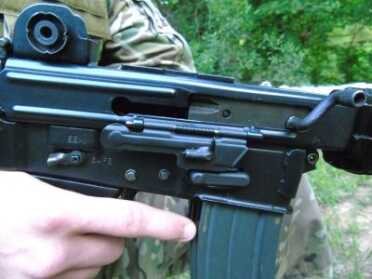
The receivers of the AR180 were pressed out of sheet steel for ease of production. The rigid charging handle reciprocated with the bolt.
Where the M16 sports a complicated T-shaped charging handle that effectively seals the action against most battlefield grime, the AR-180 uses a rigid reciprocating appendage. This simplified implement means that the operator can just grab the bolt and muscle it around in the event of a stoppage, so there is no need for a mechanical forward assist. The recoil system on the AR-180 is in the forearm, so the buttstock is free to fold to the side. The magazine releases on both guns are philosophically different yet mechanically similar.
The rear sight on the AR-180 is easily adjustable without a tool, while that of the M16 requires the point of a bullet. The front sights on both guns are nicely fenced and similarly adjustable for elevation with any sharp implement. The selector on the AR-180 is stamped but is in the same spot and works the same way as that of the M16.
Both the AR-180 and M16A1 use the same magazines with a caveat. The magazine release of the AR-180 grabs the magazine via a thin slot not typically present on most M16 boxes. A steady hand with a Dremel tool and a cutoff wheel will convert an M16 mag to AR-180 standards in maybe five minutes.
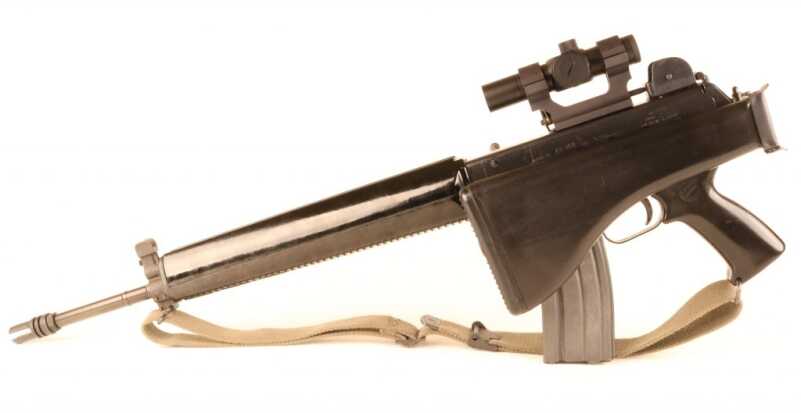
The solid buttstock of the AR180 was free to fold, as the recoil system was all contained forward in the forearm.
Range Work
Both the M16A1 and the AR-180 have barrels of similar heft. This makes them both lightweight and maneuverable guns. Recoil from the 5.56mm is piddly no matter what throws it, so both guns are comparably pleasant.
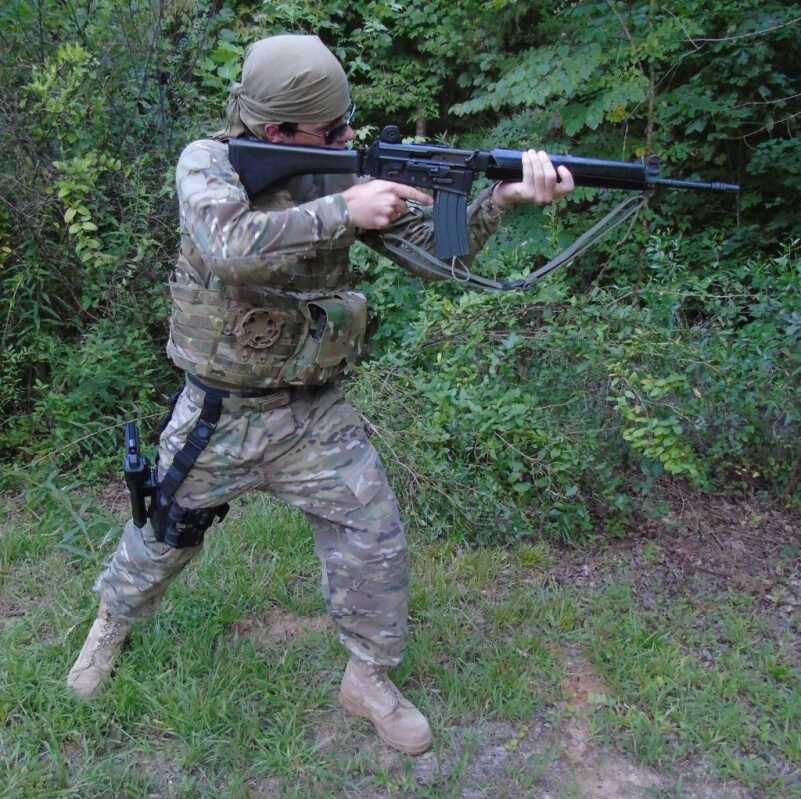
The AR-180
Performance Specifications
M16A1/AR-180
Load Velocity Group Size
Federal 55-gr. FMJ 3,144 fps/3,029 fps 2.75 in./3.2 in.
Velocity is the average of 3 rounds fired across a Caldwell ballistic Chronograph oriented 10 feet from the muzzle. Group Size is the best four of five shots measured center to center fired from a simple rest at 100 meters.
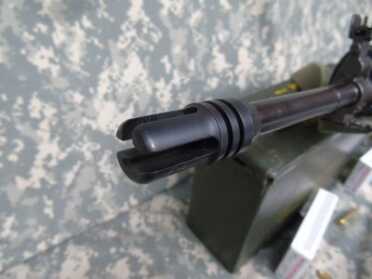
The flash suppressor on the AR180 was left open like that of the very early AR-15.
The buttstock on the M16A1 is beefier and subsequently a bit more comfortable than that of the later rifle. In these heady days of collapsing and telescoping everything, it is easy to forget how awesome that old solid M16 stock feels against your cheek. As a result, the M16A1 is slightly more manageable at longer ranges.
Both rifles are about the same length, so they both move around corners at about the same rate. The side-folding stock of the AR-180 makes for handier storage, but I can imagine no circumstance under which one might want to run the gun in this configuration. The open-tipped flash suppressor on the AR-180 grossly differs from the closed birdcage of the M16A1, but they seem comparably effective in dim light.
The real differences between these two platforms arise when you run the guns fast. My M16A1 drops its magazines freely and quickly when you stroke the magazine release. My AR-180 usually requires a little tug. Both guns lock their bolts to the rear on the last round fired.
The ergonomics for the M16 set the world standard. Refresh the magazines and slap the bolt release to get the M16 back in action. Only the Thompson submachine gun is faster. On the Tommy gun, the bolt locks back on the last round and you simply swap magazines and squeeze the trigger to get the gun running again. In the case of the AR-180 one must pull back slightly on the charging handle to release the bolt over a fresh magazine. To do so quickly inevitably involves tilting the gun slightly to improve access with the weak hand. This chore is almost as fast though incrementally more complicated than the similar drill on the M16A1.
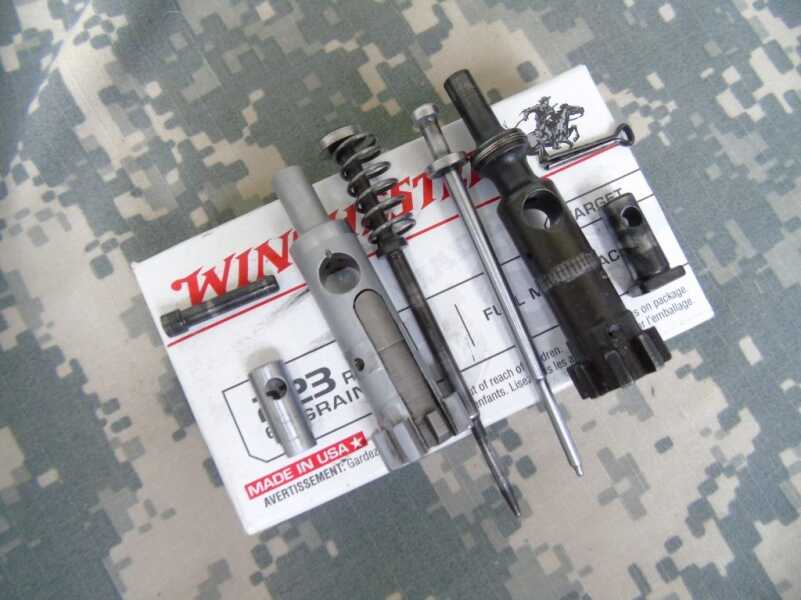
The bolt assemblies of the AR-180 and the M16A1 are similar but not interchangeable.
Parting Shots
The AR-180 was markedly easier to build than was the M16A1, and it benefitted from a generation’s worth of engineering evolution not available in 1956 when Gene and his buddies birthed the AR-10. However, in its practical respects both the M16A1 and its younger sibling the AR-180 run about the same. The personality of the two rifles is different due to the twanging recoil spring in the butt of the earlier gun, but they each throw bullets with comparable alacrity. The M16A1 is incrementally faster and incrementally more comfortable than the later gun but not by a great margin.
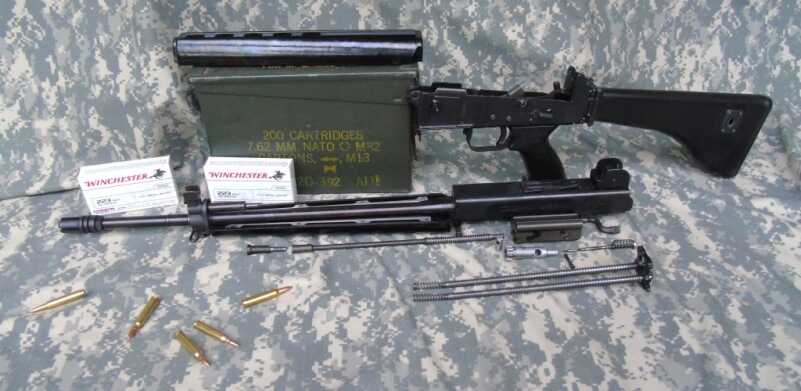
While there are distinct similarities between the entrails of the M16A1 and the subsequent AR180, differences abound.
The AR-180 never made much of a splash militarily speaking, while the M16 still soldiers on in US military service more than half a century after its conception. However, the AR180 went on to inspire the likes of the HK G36, the Steyr AUG, and the British SA80, all modern designs with plenty of combat cred. So long as each gun is shown appropriate attention with a cleaning kit they are both comparably effective tactical tools.
For more information about Federal ammunition, click here.
To purchase an AR-180 on GunsAmerica, click here.
To purchase an AR-15 on GunsAmerica, click here.
To purchase an AR-10 on GunsAmerica, click here.


I bought my Costa Mesa AR 180 from the “Gun Runner Gun Company” located near Lebanon, Mo. in 1970 after reading an article about the rifle. It cost me $270.00 back then (I still have the original sales receipt). I wish I would have had the additional $75.00 or so to have bought the scope. I was stationed at Fort Leonard Wood, Mo and that was a big chunk of the paycheck for a young Sergeant in those days. I had already been to RVN (Republic of Vietnam) as a scout in a recon platoon so familiar with the M16A1 and the Car 15 (XM 177 E1/E2). The AR 180 was accurate and reliable. I used it later at Ft. Bliss to fire the DCM Course to qualify to purchase an M1 Garand. I still have both rifles and the AR 180 has only had approximately 400 rounds put through it and is in like new condition. I also have photos when using the weapon as a prop as a US Army Ranger Instructor when acting as an aggressor against a Ranger Class. I have not fired the AR 180 since 1986 when firing the DCM Course. I realized then what a classic the weapon would become. Just thought I would share.
Sorry for the repetition. I should have read all previous comments before I got into correcting statement about bolt carrier group riding on the twin op rods in forearm.
Good article though. Good to see the venerable AR180 spoken well of, every once in a while. I have probably 6 thousand rounds through a Sterling AR180 with no more than 2 or 3 stoppages that I can remember. 2 to 3 in groups at 100yrds with open sights
with any decent 55gr ball ammo.
Thanks for the article.
One small error, and one statement that seems beyond the “nit picking” pale.
The error concerns the statement repeated several times, about the recoil / bolt carrier, twin op rods being in the forearm.
The twin op rods, and return springs mounted on a buffer plate are in the receiver, not the fore arm.
Secondly, while the AR180 does not have a bolt release lever, and yes you have to pull the charging handle a fraction of an inch to the rear to release the bolt carrier and bolt to strip first round from a fresh mag; to say this is facilitated by slightly tilting rifle forward is nonsense. Releasing the bolt group via charging handle takes only tiny fraction of second longer than modern AR bolt group release levers, is easily accomplished by any adult (right handed) and is more than made up for by the fact you actually have a handle attached to carrier group. As a 37 year shooter of the AR180, I’ll take the charging handle attached to carrier, in case of a stoppage, over the forward assist plunger on the classic AR platform, any day of the week. If need be, I can man handle
the carrier group in case of a malfunction.
I loved my AR-180 made in Essex, England. I was one prairie dog getting SOB!! Don’t listen to anyone who says they aren’t just as accurate as the AR-15. I could punch paper with the best of them, and it was dang sure more accurate than those spray and pray Ruger Mini-14s!! However, I cannot vouch for the newer ones make with polymer and I seem to remember some of them with extruded aluminum uppers – not sure on that, but I have no idea how accurate those were.
I wished I still had my AR-180 even though parts are probably impossible to get, and I would probably have to hang it on a wall. I only sold it because new ones were coming out on the market back after the turn of the century, and I thought I’d always be able to buy a new one. No such luck – I can’t believe this design is still not on the market – although they did need to make mounting rails and custom forearms easier. One of the really good things I liked was you could do ANYTHING with the shoulder stock because there was no tube structure to mess with. The tactical rifle makers don’t seem to realize that this rifle was the most modular and easy to modify and customize to your heart’s content, if they just changed it a little bit!! That is a big plus now days. but poor sales keep scaring them off – well you have to build a reputation before you can sell such things, and none of them even tried to rebuild that trust we all had back in the old ArmaLite days.
The pictures say, “M16A1″… okay, then where’s the pivot pin for the auto sear?
Like many of you, I own AR15’s, I have long wanted Armalite to re-introduce the Armalite AR-180 with updates. In fact for the second time a few days ago I expressed this notion to them via email. As a young kid in the early 80’s, I used to gawk at them in my local Army & Navy Gun Store. I love the rough looks, crazy cocking handle and all the attributes it offers, with updates in my opinion they would sell like hotcakes, especially if priced reasonably, $999 tops.
Okay, I’M being picky – Vietnam is not in ‘southwest asia’, or it wasn’t when I fought there.
Much of our exaggerated failures to function were ammo related and not really a problem with the design and execution of the M16. Kept clean, it worked.
The forward assist is redundant. If there was a failure to extract or to feed, why would you force a round into the chamber and compound the problem ?
I used M1 carbines, M3A1s, M14s and M16s, even a Stoner 63, and they all worked very well. I support this assertion by pointing out that I am still here.
Out of curiosity, why did Stoner decide to not stick with the .222 and instead created the 5.56 for his new rifle? It seems to me that using an off the shelf cartridge would have simplified things.
For your answer you need to first know the term NATO mil-spec… the 5.56 is a military cartridge with a higher pressure load , slightly taller cartridge and designed for specific military applications & has exact specifications “NATO spec” and the higher pressure increased reliability.
.223 is basically the .222 magnum. The .222 didn’t have enough “power” for a military round so they developed a .222 magnum which evolved into the .223 cartridge which evolved into the 5.56 x 45 round.
In addition, there are some differences between military and commercial ammo. Tougher primers to prevent unintended firing when charging (military rifles normally don’t have firing pin springs). Case wall thickness may be a little thicker. Military ammo runs is held to a significantly tighter dimensional tolerance than commercial ammo. When you have very little “slop” in the ammo, then if the cartridge happens to encounter a little more slop in the chamber and bolt, things still may clear. We’re talking hundreds of thousands of guns, lots of wear, mud, etc…
I own an AR-180, complete with 30 and 40 round Armalite magazines and original scope. I tried the AR15. I would not trade my 180 for three AR15. All I need to really do, is convert some AR15 mags to AR180.
A friend of mine owned an AR-18-180?? in the early ’80’s. I envied him. Wish they were more plentiful now.
I always enjoy articles about the “ early” days of Armalite and the AR-15 and AR-180. Unfortunately, this article contains a few misinformations.
To clarify nomenclature ( leaving the AR-15/M-16 out at this time) there was a typo when the author meant to reference the semi auto version of the AR-18 as the AR-180. Almost ALL rifles of this model (non AR-15) Armalites in gun shops in the 70’s and 80’s were AR-180’s. AR18’s are rare and would have only been in the hands of class 3 dealers. Walking into a local gun shop back in the day would have mostly refered to only semi auto rifles. To refer to an “AR-18” is to refer to a full auto rifle.
It is mentioned twice that the AR-18/180 operating springs or mechanism is located in the fore end. This is incorrect. There IS a return spring on the gas rod that returns the gas piston forward after each round fired, but the rifle’s recoil springs for the bolt carrier group ( that which causes fresh rounds to be stripped from a magazine and fed into the barrel’s chamber) is located within the stamped upper receiver of the rifle. This in turns leaves the buttstock free for a folding mechanism since no “ operating” parts are contained within. A significant deviation from the AR-15’s massive recoil spring inside a hollow buffer tube contained in the buttstock is the AR-18’s twin action rods. In the 180’s design the block like bolt carrier recoils along those rods and recoil springs on each rod compress and then force the bolt carrier forward to strip rounds from the magazine. This portion of the rifle’s operating system are contained within the square, folded and welded upper receiver.
Also, a comment on photo ID, as the firing pins in the detailed image of the individual bolts are reversed. The firing pin with return spring is from the “180”. It is displayed along side the AR-15 bolt.
The final curiosity to me is the author’s reference to finally accepting the idea of a stamped, bent and welded construction process becoming acceptable after his introduction to the FAL. FAL construction actually harks back to earlier processes and milled metal of all steel construction. The only part of the FAL that is stamped and welded is the lower receiver which houses the trigger components. Possibly he meant to reference the “ FNC”, which is of a similar construction as the AR-18? The FNC’s upper is of stamped, folded and welded steel while the lower receiver on an FNC goes full circle in being an aluminum block that is milled to completion, just like the AR-15/M16.
Thank you for bringing this to our attention. It was an error that was induced during editing and has been fixed!
Nice article. I haven’t thought about AR-18s in decades.
Just a couple of points. First, the Stoner system is _not_ direct impingement. Stoner says so in the patent. The Stoner system has a piston: it’s called “the bolt.” The cylinder of Soner’s piston system is the bolt carrier. The carrier key is a hollow passage that allows expanding combustion gases to enter the bolt carrier behind the piston. These expanding gases force the piston (bolt) forward and the gas cylinder (bolt carrier) rearward.
A true direct-impingement system such as the Ljungman and the MAS-44 has a “carrier key” that’s solid. The gases come out of the gas tube and push directly (directly impinge) on the face of the carrier key. It’s like a Garand, except that the “op rod” is the blind carrier key, which latter is much, much shorter than the Garand’s operating rod.
I know that I’ll never get the true nature of the Stoner system across to the gun world, but every once in a while something compels me to speak up. The Stoner system is not “DI,” it’s “Internal Piston.”
As for the AR-18 abandoning the original Stoner system in favor of an external piston, that change was forced on Stoner by the sale of the internal piston patent to Colt as part of the AR-15 deal. If you look at the bolt carrier of the original prototype AR-18, you can see where the gas admittance hole in the middle of the carrier was plugged. While the AR-18 bolt has the same tail as the AR-15’s bolt, the AR-18’s bolt lacks the “gas rings” that are the piston rings in the AR-15’s internal piston setup. The external piston system of the AR-18 doesn’t need a piston with a tail, but there it is as evidence of the original internal-piston concept for the AR-18, a concept that Stoner could no longer use.
You can find all the details and photos/illustrations in “The NEW AR-15 Complete Owner’s Guide” by some guy named “Kuleck.”
Regards,
Walt Kuleck
I’ve tried to explain the internal piston of the AR15/M16 family to several guys. Those who understand how a piston engine works usually get it pretty quick. The others? Not so much.
Thanks for your info. I’ll see about getting a copy of your book.
You’re very welcome, Mike. Until I read the patents carefully, I didn’t realize just how important the “pressurization” of the bolt carrier group is to the function of the AR-15. For example, without the pressure within the carrier pushing the bolt forward as the bolt rotates and unlocks, the bolt lugs drag on the barrel extension recesses during unlocking. That drag helps explain why external piston rifles, without that compensating pressure, put a lot more strain and wear on the bolt lugs. With the pressurization of the Stoner system, the bolt lugs are pushed forward and thus don’t drag (or at least don’t drag so much) as they rotate from locked to unlocked.
Best,
Walt
Dang! Good info. Thanks man.
Nice read, thanks.
My favorite version of the AR 18 has always been the G36. Wish HK didn’t hate me though……
I purchased my first AR in 1978. Colts civilian version the SP-1 for $475. It was my first semi-auto centerfire rifle. The noticeable “twang” in my left ear when firing added credibility to the Mattel Toy like description our soldiers gave it. But it was a fun shooter. A year or so later I saw an AR-180 on the wall of my local Gun store. It looked good from 10 feet away but on close inspection looked like it was made in a Muffler shop. The stamped steel reciever was hand welded with a oxyacetylene torch, being evident by the weld bead ripples. Compared to the Forged aluminum reciever of the AR is looked cheap And it wasn’t cheap at all, as it was in the $600 range. I didn’t buy it which today I know was a big mistake. Being newly married at the time my overtime pay would no longer be going for toys. In the early 80’s I also kick myself for walking away from the HK 91, 93, and the FN CAL, all in stock locally for a hefty sum. I had an aversion to sheet metal rifles with hand welds. I was a trained welder and the not so attractive weld beads on these guns looked like monkeys were doing the welding. In 1985 I was working mandatory 80 hour weeks when I saw an ad in Shotgun News for an FN FAL. The real deal. A Belgian made Gun South imported beauty. It was the FAL that changed my mind about welded sheet metal receivers. And so
I bought one. Today I wished I had bought a dozen
Author is obviously knowledgable, and being rotorcraft-rated is definitely an exceptional human being.
However, I was disappointed in that I did not see him mention the AR-180’s most significant feature, which places it far above the AR-15/M16/M4 rifles in reliability: the piston gas system. (If I somehow missed it I apologize.)
Not blowing carbon and unburnt powder all over the bolt and chamber is a really good thing. Even better is not blowing carbon and unburnt powder all over the ammo in the magazine. These two things make the 180 superior, and is why the over-priced (and poorly supported for civilians) HK gas piston weapons have been the choice of those who want the extra protection of improved reliability.
Sure, as the good Doctor says, time spent properly cleaning both will make them close to equal in reliability, but I understand (I wasn’t there, being Vietnam-era – not a Vietnam vet) from guys who served in the Sandbox, in an extended firefight where there is no opportunity to stop and clean your rifle, the M4/M16 series can develop problems that well-designed gas piston rifles (like the AR-180) don’t encounter.
Doc is entitled to his opinion and apparent preference for the M4/M16 line, having used them effectively in Vietnam, but if he had a chance to use the Stoner gas piston system while in-country, he might have changed his tune. Thanks for an otherwise great article, Doc.
I should have added, as others already have, that the twin rods and springs of the recoil system on the 180 are indeed in the receiver. I’m use to the “boink” of the recoil spring/buffer in my wife’s Bushmaster M-4gery (to which I have added the Adams Arms carbine piston kit, a very close copy of the AR-180 piston system), but I truly love the gas piston system in both rifles. I have two sets of spare springs for the AR-180 recoil rods, but I have not needed them so far after about 15K rounds through the rifle.
The US military replace the M-16 with this rifle. The AR-18 is more reliable with it’s gas piston and much cheaper to produce with it’s stamped metal receivers.
The M16 has only been replaced with M16/M4 variants and the M249 SAW where needed. The AR18 was tested and never adopted by the U.S. Military. The IRA loved them.